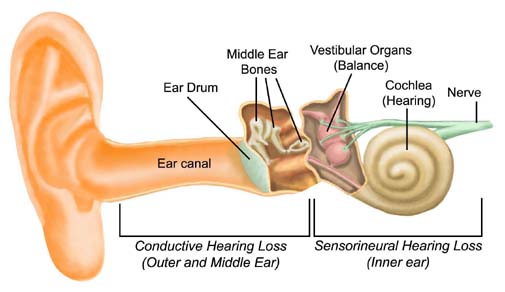
image from The Harvard Med School Center for Hereditary Deafness
| MadSci Network: General Biology |
Em-
That's a really great question! It does seem weird that people who can't seem to hear anything can speak.
I'll try to answer your question the best I can. I will undoubtedly leave out some bit of information or detail, but I've tried to give you links to find more information in case you're curious.
The first consideration is: When did they become deaf? If they became deaf after they had learned to speak, they should be able to faithfully repeat what they've learned. The quality of their pronunciation may drift a bit - I'll discuss that below.
But what about if they've been deaf from birth? The story
gets a little more clear when we ask the
question: what is deafness? Well, we both know it means that a person
can't hear. But there are different reasons
why that could be. To understand, let's look at the structure of the
ear:

The major parts of the ear are the pinna, or ear lobes, the eardrum, middle ear bones, cochlea, and the auditory nerve, as diagrammed above. And the diagram makes references to two types of hearing loss: "Conductive Hearing Loss" (CHL) and "Sensorineural Hearing Loss." (SHL) These two, major classes of deafness are very different in cause and thus can different effects on the way the person can deal with sound. I'll describe them in a minute.
The outer and middle ear transduce vibrations in the air
into movement of fluid in the cochlea. The
ear drum vibrates when sound hits it, and this causes the bones to
vibrate, too. The stirrup bone is connected to a
little flap on the cochlea, called a 'window' (sort of like another
eardrum, but on the cochlea). A simplified
description of the cochlea is that it's a fluid filled tube. When the bone
presses against the cochlear window, it
increases the pressure of fluid inside, and specially designed receptors
can sense this pressure. A more detailed
description of what happens can be found here.
These specialized receptors in the cochlea transform the
pressure signal into a neural signal, and
the nerve carries this transformed signal to the brain, where it can be
interpreted. These are the real 'sound
translators.'
So if we think of 'what makes a person deaf?' Two major
ways arise: the structures which transform
the air vibration into fluid vibration could be damaged [CHL] ; or the
structures which transduce a pressure signal
into a neural signal (or carry that signal to the brain) could be damaged
[SHL]. If a person has CHL, the sound
translator (cochlear/nerve) still works, so there is a greater chance they
can hear. They might be
able hear themselves speak (because in talking, we vibrate our own bones a
bit), but not outside sounds. Some
hearing aids work by vibrating the skull a bit near the ear bones, and
that provides enough vibration for the
cochlea to work. In more extreme cases, special devices can be implanted
into the cochlea. These Cochlear
Implants have been quite successful. They basically work by bypassing
the outer and middle ear bones, and
stimulate the cochlea directly.
If a person has SHL, the situation is much more dire. We
don't know enough about how the nervous
impulses are sent, organized, and understood by the brain to really
control this. With our current technology, we
can't do much for these patients.
An analogy could be this: If your light turns off, it
could be because the lamp itself is broken
(CHL) or that the bulb is out (SHL). The lamp merely provides a round
socket to hold the light bulb and connects it
to the power source; you could probably plug a wire into the socket and
make a little socket out of metal to get the
bulb to work (but DO NOT try this!!!). But the bulb is what's designed to
turn an electrical current into light. We
could plug every lamp into every socket in the world, but if there are no
bulbs, we have no light... In the same
way, if we have no cochlear or nerve, we can't get the neural signal to
the brain. Unfortunately, replacing cochleas
isn't as easy changing light bulbs.
SO, back to your original question: A person who is born
with CHL may learn to speak using devices
which bypass some of the auditory structures or hijack the cochlea. The
speech may not be perfect, but it should be
good enough to communicate. But a person with SHL is highly unlikely to
be
able to make proper sounds for speech (at least in this day and age). (or
if they became deaf after learning to
speak, their speech may become more distorted, as they don't know to
correct any mispronunciations)
I hope this sheds some light on how people hear, and how a
person who is deaf may be able to make
sound!
Here are some the sites I used for this info:
http://deafness.about.com/
http://hearing.harvard.edu/ind ex.html
http://www.med.harvard.edu/publications/On_The_Brain/Volume3 /Number4/Cochlear.html
http://thalamus.wustl. edu/course/audvest.html
-Alex Goddard
cgoddard@fas.harvard.edu
Try the links in the MadSci Library for more information on General Biology.